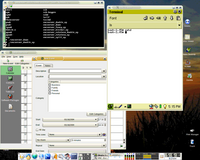
This comes from the afore mentioned HOWTO:
% ifconfig usb0 192.168.129.1 netmask 255.255.255.255 up % route add -host 192.168.129.201 usb0
Now ping should see the device, assuming you left the network configuration as default on the Zaurus. Run:
% ping -c 3 192.168.129.201 # the -c n option makes it stop after n packetsThe output should be similar to the following (Control-C also cancels)
PING 192.168.129.201 (192.168.129.201) 56(84) bytes of data. 64 bytes from 192.168.129.201: icmp_seq=0 ttl=255 time=1.24 ms 64 bytes from 192.168.129.201: icmp_seq=1 ttl=255 time=1.26 ms 64 bytes from 192.168.129.201: icmp_seq=2 ttl=255 time=1.07 ms --- 192.168.129.201 ping statistics --- 3 packets transmitted, 3 received, 0% packet loss, time 2015ms rtt min/avg/max/mdev = 1.075/1.196/1.267/0.085 ms, pipe 2
If packets are being received it means the machines can now communicate!
Now to get this working on rebootCreate '/etc/hotplug/usb/usbnet' to contain the following (Note: this is not usbdnet):
#!/bin/bash typeset -i num num=`ifconfig | grep usb0 | wc -l` if [ $num -eq 0 ] ; then ifconfig usb0 192.168.129.1 netmask 255.255.255.255 up route add -host 192.168.129.201 usb0 fi iptables -t nat -F iptables -t nat -A POSTROUTING -j SNAT -o eth0 --to MY_IP echo 1 > /proc/sys/net/ipv4/ip_forward exit 0
To test, reboot the Fedora box with the Zaurus in its cradle and running. Everything should work. To check use the ping test mentioned above from a terminal.
Congratulations! You can now communicate reliably between your Zaurus and Fedora box.
I started the ssh and vnc servers on my Zaurus and am now able to ssh to it as well as
bring up the Zaurus display on my desktop (these programs need to be separately installed on the Zaurus):

screenshot (222k)